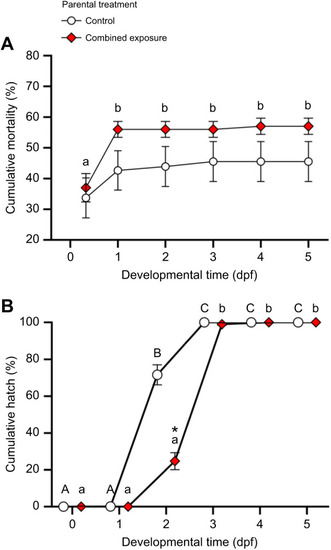
Effects of parental treatment on zebrafish offspring cumulative mortality and cumulative hatch. (A) Cumulative mortality; (B) cumulative hatch. Offspring were derived from adult zebrafish exposed to either control or combined exposure conditions for 14 days. Statistical differences between values were determined with Kruskal–Wallis one-way ANOVAs followed by Tukey post hoc tests [across developmental time (dpf); A: control: P=0.485; combined exposure: P=0.005; B: control: P<0.001; combined exposure: P<0.001], and between parental treatments with Mann–Whitney rank sum tests (A: 8 hpf: P=0.250; 1 dpf: P=0.034; 2 dpf: P=0.041; 3 dpf: P=0.060; 4 dpf: P=0.060; 5 dpf: P=0.060; B: 0 dpf: P=1.000; 1 dpf: P=0.342; 3 dpf: P=0.040; 4 dpf: P=1.000; 5 dpf: P=1.000) or two-tailed t-tests (B: 2 dpf: P<0.001). Assessment of each treatment group was performed at the same developmental time but are presented offset for presentation clarity. Values within a given treatment that do not share a common letter are different from one another. Differences between treatments for a given developmental time are indicated by an asterisk. Data are means±s.e.m. (n=20 for each time point for both treatments, for both graphs).
|

